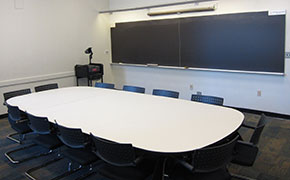This Course at MIT pages are part of the OCW Educator initiative, which seeks to enhance the value of OCW for educators.
Course Overview
This page focuses on the course CMS.701 Current Debates in Media as it was taught by Dr. Gabrielle Trépanier-Jobin in Spring 2015.
This class addresses important, current debates in media with in-depth discussion of popular perceptions and policy implications. Students engage in the critical study of the economic, political, social, and cultural significance of media, and learn to identify, analyze, and understand the complex relations among media texts, policies, institutions, industries, and infrastructures. The class offers the opportunity to discuss, in stimulating and challenging ways, topics such as ideology, propaganda, net neutrality, big data, digital hacktivism, digital rebellion, media violence, gamification, collective intelligence, participatory culture, intellectual property, artificial intelligence, etc., from historical, transcultural, and multiple methodological perspectives. Students examine the framing of these issues, their ethical and policy implications, as well as strategies for repositioning the debates.
Course Outcomes
Course Goals for Students
- Demonstrate, through oral presentations, discussions, and written works, an understanding of the current debates in media
- Engage with complex ideas, opening up to different perspectives, and developing critical thinking skills
- Learn how to discriminate between reliable and unreliable sources of information
- Analyze cultural objects critically and situate this analysis in a particular theoretical framework
- Use the thesis/antithesis/synthesis method to build strong and nuanced argumentation
Below, Dr. Gabrielle Trépanier-Jobin shares the pedagogical tools and methods she used to teach each session of CMS.701 Current Debates in Media.
► Session 1: Ideologies, Stereotypes, & Agency
Students worked in teams of 3-4 to create a conceptual map of different sections from Stuart Hall’s (2004) text “Culture, the Media and the ‘Ideological Effect’” with the help of the software CmapTools. The best conceptual maps were presented to the rest of the class.
► Session 2: Propaganda, Censorship, & Net Neutrality
Students were introduced to propaganda techniques and were asked to identify them in a series of images or videos.
► Session 3: Violence in Media and Video Games
Students worked in teams to prepare an argumentation for or against the idea that: 1) media violence is exaggerated, 2) more regulations should be implemented to control media violence and 3) violence in video games is more problematic than violence in films or television shows.
► Session 4: From Big Data to Big Brother: Surveillance and Privacy in the Information Age
Students worked in teams of 3-4 to identify rhetorical strategies in Google’s, Facebook’s, Twitter’s, Amazon’s, Netflix’s, Skype’s, Instagram’s, and YouTube’s Terms and Services that work ideologically to downplay privacy risks and make the users believe that decisions were made for their own good.
› Read More
Curriculum Information
Prerequisites
CMS.100 Introduction to Media Studies
Requirements Satisfied
HASS ![]()
Offered
CMS.701 Current Debates in Media is offered intermittently.
Assessment
The students' grades were based on the following activities:
 15% Class participation
15% Class participation 35% Class presentation
35% Class presentation 40% Dissertation
40% Dissertation 10% Participation in the class project
10% Participation in the class projectStudent Information

Breakdown by Year
Mostly undergraduates
Breakdown by Major
Mostly majors and minors in comparative media studies
During an average week, students were expected to spend 12 hours on the course, roughly divided as follows:
In Class
- Met once per week for 3 hours per session; 14 sessions total; mandatory attendance.
- Each week, one student presented for 30 minutes on a media artifact or relevant event. Presentations were followed by a 20-minute period of questions and discussion, moderated by the student who presented.
- For a detailed description of each session's learning activities, please see Instructor Insights.
Out of Class
- Preparation for class discussions by completing assigned readings and posting discussion questions/topics on the class forum
- Preparation for a 30-minute presentation on a media artifact or a relevant event
- Term paper on a current debate of the student's choice
- Collaboration on a media analysis project with classmates
Semester Breakdown
| WEEK | M | T | W | Th | F |
|---|---|---|---|---|---|
| 1 |  |  |  |  | |
| 2 |  |  |  |  |  |
| 3 |  |  |  |  |  |
| 4 |  |  |  |  |  |
| 5 |  |  |  |  |  |
| 6 |  |  |  |  |  |
| 7 |  |  |  |  |  |
| 8 |  |  |  |  |  |
| 9 |  |  |  |  |  |
| 10 |  |  |  |  |  |
| 11 |  |  |  |  |  |
| 12 |  |  |  |  | |
| 13 |  |  |  |  |  |
| 14 |  |  |  |  |  |
| 15 |  |  |  |  |  |
| 16 |  |  |  |  |  |
 No classes throughout MIT
No classes throughout MIT Lecture session
Lecture session Student presentations
Student presentations No class session scheduled
No class session scheduled Guest speaker
Guest speaker Assignment due date
Assignment due date

 Room 1 of 1
Room 1 of 1 